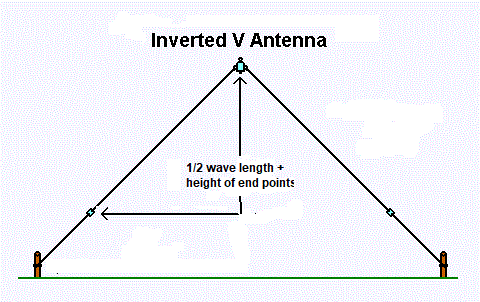


The basic formula for determining the wire length of a center fed, 1/2 wave wire dipole or inverted Vee antenna (30 mhz or less) is 468/freq-in-Mhz for feet and inches or 143/freq-in-Mhz for meters .
The inverted Vee antenna legs will be longer by 2 - 6% from those of the horizontal antenna depending on the angle. This calculator assumes an apex angle of 90 degrees or 45 degrees from hoizontal for each leg and uses an increase of 5%. For angles greater then 90 degrees the legs will have less of an increase in length.
The minimum height of the antenna should be 1/2 wave length and for the inverted V antenna, add the height of end points above ground for the minmum height of the antenna feed point.
Remember that location, height, obstructions, wire type, wire coating, etc will effect the calculated lengths. Always cut your wire a little longer and then trim for your installation.
A horizontal 1/2 wave length dipoles will have a feed point of about 73 ohms while the inverted vee antennas have a feed point of about 52 ohm's. Both can be used with or without a 1:1 balum although the use of a 1:1 balum will change the feed point of the unbalanced coax to a balanced antenna load there by reducing the chance of radiation from the feed line.
NOTE: The previous Calculator used here and most other Calculators found show the inverted V antenna legs as being shorter by 2 - 5% based on the angle when really they should be longer by 2 - 6%. When the legs of a horizontal dipole antenna are slooped, the resonant frequency of the antenna is increased, therefore to bring the antenna back to the same lower resonant frequency the legs must be increased in length. This error seems to have come from the ARRL Hand Books that all show this error from the 50's through the 90's. Not sure when it was corrected but the 2003 book now shows it correctly.
This calculator is designed to give the vertical length (height) of a particular antenna, for the frequency and wavelength chosen. This does NOT take into consideration the type or size of horizontal reflectors, of even if there is a need for them. Enter the desired frequency and select the wavelength. Click on Calculate and the optimum length for that combination will be displayed in feet, inches and fractions of inches, and in meters. To optimize the antenna for a frequency RANGE, do the calculations twice, once for the low end of the range and once for the high end; then average the two and plan to adjust the VSWR on both ends of the range as needed.